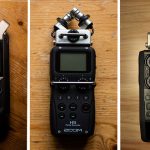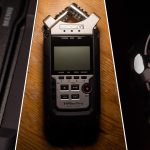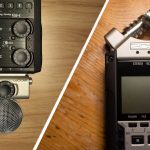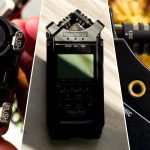So it’s been a while since you bought your H4n Pro recorder and you’re wondering whether to upgrade to the shinier Zoom H5.
Perhaps you want to explore new avenues and expand your recording possibilities. So you’re wondering, “Is the H4n Pro still right for me, or should I splash out and buy the Zoom H5?”
Or maybe you don’t own a portable multi-track recorder yet, and you’re trying to figure out what to buy?
In this article, I will help you decide by exploring the features of Zoom’s H4n Pro and the slightly more expensive H5. We’ll look at what they can and can’t do, in order to help you decide which is the one for you.

Inputs
Both the Zoom H5 and the H4n Pro come with two XLR inputs and a 3.5mm mini-jack input.
That means that you can plug in microphones, such as a podcast or shotgun mic instead of using the X/Y mic on top. The mini-jacks allow you to plug in smaller mics such as a lavalier mic. This comes in handy if you want to record the audio for a YouTube video for example, and you want to be a distance away from the camera, but you don’t want to use a wireless lavalier mic.
Bear in mind that the Zoom H5 allows for more flexibility than the H4n Pro because you can clip on a capsule which adds two more XLR inputs. It’s as easy as changing a camera lens and allows you to record two more separate voices, which increases your podcasting options.
It is important to bear in mind the fact that the additional two inputs that you can add via the capsule can not be provided with phantom power. If you’re using dynamic microphones, that’s not an issue, but if you’re using condensers, then it won’t work.
If you’re not sure which one you have, simply look up the specs of your microphone. They will mention whether it’s a condenser, or a dynamic mic.

Size & Build
Both of these recorders are compact and easy to handle. Their rugged, sturdy build gives you the confidence to take them out and about. They are similar in size, too, with the H5 coming in slightly smaller and lighter at just 9.52 oz (269 grams) compared to the H4n Pro’s 280g.
What’s more, each model comes with a plastic case, designed to protect it from scuff marks and knocks in your bag as you travel around. The Zoom H5 case is cushioned for extra safety and protection, whereas the H4n Pro case is a more basic affair.
Free Sound Effects
By the way, did you know I have compiled the largest list of free sound effects in the world? Over 500GB of sounds, ready to be downloaded, free of charge. Just figured you’d want to know. And now, back to the review.
Display
The displays on these recorders are the same. Both have a 1.9 inch backlit LCD screen which is helpful in lowlight conditions, allowing you to see without straining your eyes.
It’s easiest to view these screens looking straight down from above, but if you have to mount either recorder on a DSLR camera, then it can be challenging to see the screen.
I do think Zoom should consider building swivel screens into their recorders because you could then easily adjust the angle, so you can keep an eye on your levels no matter what.
Sound Quality
You want the best sound quality possible in a portable recorder. Both recorders work beautifully inside, but how do they stack up outside?
Well, if you’re recording outside, wind noise can be a real problem. The H4n Pro has no extra wind protection whereas the Zoom H5 comes with a foam windshield. However, this is still not really adequate protection against the wind so I’d recommend that you invest in a Rycote kit which includes a highly protective windshield as well as a shock mount and grip. I’ve embedded these products down below.
Both the H4n Pro and the H5 will record high-quality audio at up to 24bit/96kHz, which is far more than the 24bit/48kHz you need for a voice-over or dialogue. In fact, 24bit/96kHz is more than 99% of people will ever need.
In terms of sound quality, they’re both basically the same. It’s important to note that the Zoom H4n Pro should not be confused with the older H4, which had noisier preamps.
If you need to record relatively loud sound sources, such as your voice, outdoor ambiences, instruments that are not too quiet, and general sound effects close-up, then they’ll perform great.
If on the other hand you want to record super quiet natural ambiances, or very subtle and quiet sound effects, investing in a Sony PCM-D100 might be better.
Storage
Zoom recorders don’t have internal storage. Instead, they record directly to SD cards up to 32GB in size. That is a huge amount and, depending on what you’re recording, could give you up to 2000 minutes.
Bear in mind that some people have found that the H4n Pro has an issue with larger SD cards as it seems to take longer to start up with a 32GB card inserted. I have found that this problem can significantly reduced when you format the card directly in the recorder.
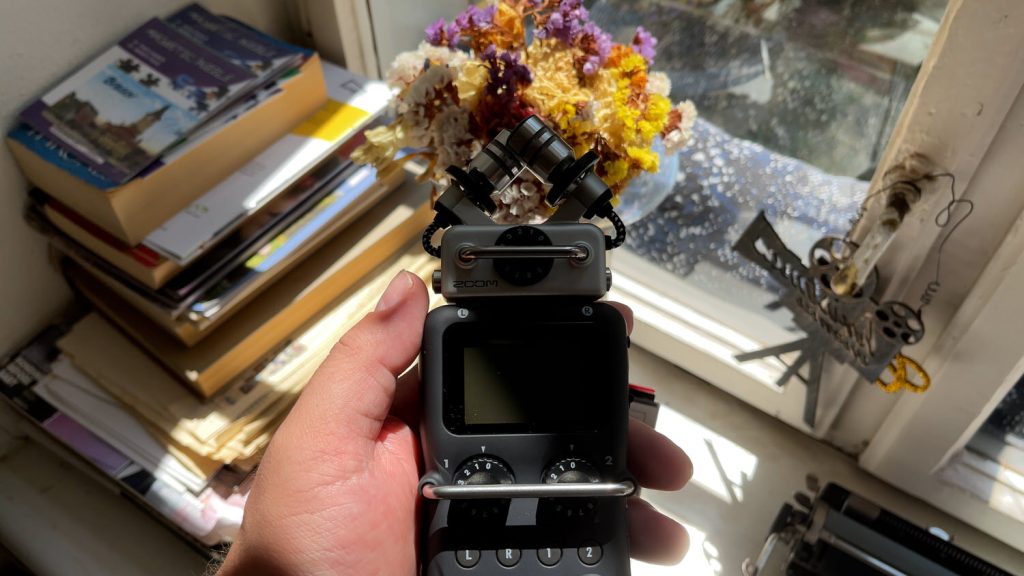
Batteries
Both recorders take two AA batteries, and I would always recommend taking some spares with you when you go out recording. The H4n Pro has a battery life of only six hours but the Zoom H5 more than doubles that, giving 15 hours in ideal conditions.
Results can vary, depending on the battery brand and age, as well as your recording settings.
Versatile Recorders
The H4n Pro and the H5 are both designed to record on the go, but you can also use them as an audio interface for your computer or laptop. That is easy to do, as you simply plug the recorder in via a USB cable and set it up accordingly.
But remember that extra two-input clip-on capsule which is available on the H5. It can save a lot of frustration and workarounds to plug in two additional mics when you need them.
Modularity
With the H4n Pro, what you see is what you get. While you can purchase extras such as the Rycote windshield, it isn’t a modular recorder.
On the other hand, the H5 allows you to use several clip-on capsules (such as the Zoom EXH-6) to increase its usefulness. Simply put, if you need a shotgun mic, but you don’t want to carry one around, you can purchase that module and easily connect it to the Zoom H5. You just remove the X/Y microphone module by pressing the two buttons on the side and clip the new module on in its place.
It is important to note that the extra capsules need to be purchased separately, as the Zoom H5 only comes with an X/Y and M/S capsule. Additionally, the new ‘black’ version of the recorder only seems to come with the X/Y capsule.
Levels
While you’re recording, it’s essential to monitor and adjust your levels. That is not so easy with the H4n Pro because it uses switches on the side to change the levels.
But the H5’s level controls are more accessible because it has volume wheels on the front. The left wheel controls input one, and the right wheel controls input two. What’s more, once you’ve adjusted the levels, there’s a metal bar across the top. This lowers the chance that you’ll accidentally knock the wheels and change your carefully-set levels.
Which Is The Zoom For You?
Both the H4n Pro and the H5 are rugged, sturdy, versatile recorders. They each have XLR inputs and run on AA batteries. Each one can give you great service and sound quality.
The H5 provides more versatility because of the extra modules available. Being able to add additional microphones straight onto the recorder, or clipping on two more inputs could be a worthwhile bonus.
To decide, I suggest you consider what you want to use your recorder for in the foreseeable future. Are you planning to start a podcast or envisage long trips out on the road? Will you be recording mainly inside or out? What sort of sound effects might you wish to capture? Do you intend to record music? If so, how many instruments will you be recording at the same time?
The H4n Pro is the cheaper option and will easily record both normal and loud volume sounds with reliable sound quality.
True, the Zoom H5 is a step up in price, but also in quality and versatility. If you’re thinking about a podcast or taking it outdoors a lot, then you might well consider it worthwhile to invest in the H5 instead.
Thank you very much for reading my comparison of Zoom’s H4n Pro and the Zoom H5 recorders. I invite you to have a look at some of my other articles. We have something for everyone, whether you’re interested in audio, or cameras and lenses. Alternatively, if you prefer video reviews, feel free to have a look at my YouTube channel.
